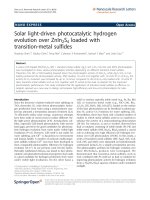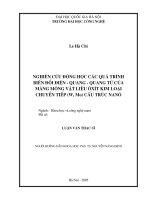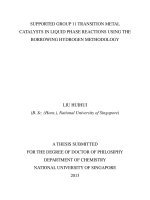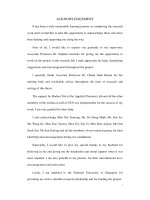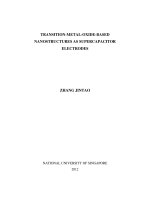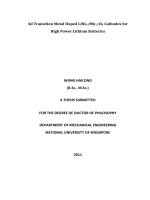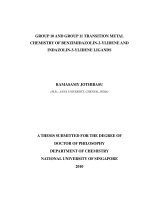gerloch - transition metal chemistry (vch, 1994)
Bạn đang xem bản rút gọn của tài liệu. Xem và tải ngay bản đầy đủ của tài liệu tại đây (14.15 MB, 223 trang )
M.
Gerloch, E.G. Constable
Transition Metal Chemistry
VCH
Transition
Metal Chemistry.
M.
Gerloch,
E. C.
Constable
Copyright
©
1994
VCH
Verlagsgesellschaft mbH, Weinheim
ISBN:
3-527-29218-7
©
VCH
Verlagsgesellschaft mbH, D-69451 Weinheim (Federal Republic
of
Germany), 1994
Distribution:
VCH, P.O.
Box
101161,
D-69451 Weinheim, Federal Republic
of
Germany
Switzerland:
VCH, P.O. Box, CH-4020 Basel, Switzerland
United Kingdom
and
Ireland: VCH,
8
Wellington Court, Cambridge
CBl
IHZ, United Kingdom
USA and
Canada: VCH,
220
East 23rd Street,
New
York,
NY
10010-4606,
USA
Japan: VCH, Eikow Building, 10-9 Hongo 1-chome, Bunkyo-ku, Tokyo 113, Japan
ISBN
3-527-29218-7 (VCH, Weinheim) ISBN 1-56081-885-9 (VCH,
New
York)
Malcolm Gerloch, Edwin
C.
Constable
Transition Metal
Chemistry
The
Valence Shell
in
d-Block Chemistry
Weinheim
· New
York
Basel
·
Cambridge
·
Tokyo
Dr.
Malcolm
Gerloch
University
Chemistry Laboratory
Lensfield
Road
Cambridge
CB2 IEW
United Kingdom
Prof.
Dr.
Edwin
C.
Constable
Institut
fur
Anorganische Chemie
Universitat
Basel
Spitalstr.
51
CH-4056 Basel
Switzerland
This
book
was
carefully
produced. Nevertheless, authors
and
publisher
do not
warrant
the
information
contained therein
to be
free
of
errors. Readers
are
advised
to
keep
in
mind that statements, data,
illustrations, procedural details
or
other items
may
inadvertently
be
inaccurate.
Published jointly
by
VCH
Verlagsgesellschaft, Weinheim (Federal Republic
of
Germany)
VCH
Publishers,
New
York,
NY
(USA)
Editorial
Director:
Dr.
Thomas Mager
Production Manager:
Elke
Littmann
Library
of
Congress Card
No.
applied for.
A
catalogue record
for
this book
is
available
from
the
British Library.
Die
Deutsche
Bibliothek
-
CIP-Einheitsaufnahme:
Gerloch, Malcolm:
Transition metal chemistry:
the
valence shell
in
d-block
chemistry
/
Malcolm Gerloch; Edwin
C.
Constable.
-
Weinheim;
New
York; Basel; Cambridge; Tokyo: VCH, 1994
ISBN 3-527-29219-5 (Weinheim ) brosch.
ISBN 3-527-29218-7 (Weinheim )
Gb.
ISBN
1-56081-884-0 (New York)
NE:
Constable, Edwin
C.:
©
VCH
Verlagsgesellschaft mbH, D-69451 Weinheim (Federal Republic
of
Germany), 1994
Printed
on
acid-free
and
chlorine
free
paper
All
rights reserved (including those
of
translation into other languages).
No
part
of
this book
may be
reproduced
in any
form
- by
photoprinting,
microfilm,
or any
other means
- nor
transmitted
or
translated
into
a
machine language without written permission
from
the
publishers. Registered names, trademarks, etc.
used
in
this book, even when
not
specifically
marked
as
such,
are not to be
considered unprotected
by
law.
Composition: Hagedornsatz
GmbH,
D-68519 Viernheim. Printing: betz-druck gmbh, D-64291 Darmstadt.
Bookbinding: Industrie-
und
Verlagsbuchbinderei Heppenheim GmbH, D-64630 Heppenheim.
Printed
in the
Federal Republic
of
Germany
To
our
wives,
Gwynneth
Neal-Freeman
and
Catherine Housecraft,
for
their love, patience, hard work
and
cajolary.
Also
to
Satin, Index, Philby
and
Isis
Transition metals comprise roughly half
of the
periodic table
of
elements. Their
known chemistry occupies
a
rather larger fraction
of
non-carbon research literature
to
make
up an
enormous subject which continues
to
grow
at a
fast
rate.
No
encyclopedia
can
encompass
the
century
or
more
of
achievement,
let
alone
a
single
book. Here,
we do not
even begin
to
try. What
is
offered,
however,
is an
outline
of
a
theoretical structure
for
transition-metal chemistry
at an
elementary level that
hopefully
provides
a
consistent viewpoint
of
this widely varying
and
fascinating
subject.
By
'elementary'
we
mean early-to-mid
UK
degree level,
and
essentially
non-mathematical:
we do not
mean,
on the
other hand, unsubtle, lacking
in
provocation
or
patronizing.
It
has
often
been asserted that
the
'driving forces'
of
inorganic chemistry vary
throughout
the
periodic
table
so
that
we
must
focus
on A
here
but on B
there.
If by
this
is
meant that
the
major factors
are A and B
here
and
there,
we
have
no
quarrel.
It is,
however, utterly unsatisfactory
for
anyone coming
to
grips with
the
subject
not
to
understand
why A
rules here
and not
there.
We
need
an
underlying structure
and
understanding
if we
wish more than
to
apply given recipes: something between
the
recipes
and the
impossibility
of
deriving chemistry
from
quantum theory
and
fundamental
particles. This
is a
tall order.
The
present
offering
is an
attempt within
just
the
transition-metal
series.
Although
the
last chapter relates
to the
lanthanide
series,
we are
mainly concerned with
the
first
transition
series
only.
A
central theme
in our
approach, which
we
believe
to be
different
from
those
of
others,
is to
focus
on the
changing chemistry associated with higher, middle
and
lower oxidation state compounds.
The
chemical stability
of
radical
species
and
open-
shell Werner-type complexes,
on the one
hand,
and the
governance
of the
18-electron
rule,
on the
other,
are
presented
as
consequences
of the
changing nature
of the
valence shell
in
transition-metal species
of
different
oxidation state.
A
goodly part
of any
text
on
'theoretical'
inorganic chemistry necessarily includes
an
account
of
crystal-
and
ligand-field theories. Usually, however, these
theories
are
presented
as a
self-contained discipline. Although they have certainly provided
wonderful
opportunities
for the
exercise
of
group theory
and
physics within
the
inorganic chemistry syllabus,
the
student
of
chemistry
can
well
be
forgiven
for
wondering what they actually have
to say
about chemistry.
It is
necessary
to go
quite
far
into
the
purely symmetry-based aspects
of
crystal-field theory
if
only
to
explain
the
number
of
bands that occur
in the
spectra
of
transition-metal species
or
the
gross features
of
their magnetic properties.
And we do so in
this book also,
although
we do not
take
the
space
to
cover these matters
all the way to the end of a
UK
bachelor course. What
we do
focus
on
particularly, though,
and
what
is
often
VIII
Preface
too
lightly skipped
over
in
many other texts,
is the
light thrown
by the
crystal-
and
ligand-field
theories upon 'chemical bonding
and
structure
in the
transition block.
This
is an
interactive enterprise
in
that
it is
equally important
to
understand
why
ligand-field
theory should
'work'
any
way It
is
also important
-
though subtle,
so
we
only make
a
start
on it - to
appreciate
the
utterly
different
nature
of
ligand-field
theory
on the one
hand,
and of
molecular-orbital theory
on the
other.
In
all
these discussions,
we
separate,
as
best
we
might,
the
effects
of the d
electrons upon
the
bonding electrons from
the
effects
of the
bonding electrons upon
the
d
electrons.
The
latter takes
us
into crystal-
and
ligand-field theories,
the
former
into
the
steric roles
of d
electrons
and the
geometries
of
transition-metal complexes.
Both
sides
of the
coin
are
relevant
in the
energetics
of
transition-metal chemistry,
as is
described
in
later chapters.
We
have agonized somewhat over
the
title
of
this book. Although
it
might
put
some readers off,
we
stuck with
it for it
really summarizes
the
kernel
of our
approach. This
is not a
compendium
of
chemical syntheses
or
properties,
but
rather
an
attempt
to
bring together
in a
single
yet
non-simplistic
way
many important
bonding
and
theoretical principles that hopefully make more sense
of
this wide
and
fascinating
subject.
We
hope that
the
path
we
have plotted through this important
area
of
inorganic chemistry will commend itself
to
other teachers.
Our
lecture
courses
at
Cambridge broadly follow this scheme, many
of the
central ideas
of
which
were
first
presented
in an
article
in
Coordination
Chemistry
Reviews
(99,
1990,
ρ
199).
One of us
(M.G.) thanks Professors Bill Hatfield,
Tom
Meyer
and
their colleagues
at the
University
of
North Carolina, Chapel Hill,
NC,
U.S.A.
for
their hospitality
whilst much
of
this book
was
written.
Contents
Preface
1 An
Introduction
to
Transition-Metal
Chemistry
1
1.1
What
is a
Transition Element?
1
1.2
Complexes
and
Coordination Compounds
3
1.3
The
Coordinate Bond
5
1.4
Ligand Types
5
1.5
Coordination Number
8
1.6
Geometrical Types
and
Isomers
9
1.7
Oxidation State
12
1.8
Electroneutrality Principle
14
1.9
Rationalization
of
Complex Geometries
15
1.10 Review
of
Properties
of
Transition-Metal Compounds
17
2
Focus
on the d
n
Configuration
21
2.1
Spectral Features
21
2.2
The
Valence Shell
23
2.3 The
Roles
of d
Electrons
26
3
Crystal-Field
Splittings
27
3.1 The
Crystal-Field Premise
27
3.2
Splitting
of d
Orbitals
in
Octahedral Symmetry
28
3.3
Splitting
of d
Orbitals
in
Tetrahedral
and
Other Symmetries
32
3.4
Holes:
d
1
and d
9
34
3.5
More Transitions
for d
2
36
3.6
Atomic Orbitals
and
Terms
40
3.7
Crystal-Field Splitting
of
Free-Ion
D
Terms
44
3.8
Crystal-Field Splitting
of
Free-Ion
F
terms
46
3.9
Free-ion
S and P
Terms
in
Crystal Fields
48
3.10 Splitting Patterns
for d
n
Ground terms
52
3.11 Orgel Diagrams
56
3.12 Concluding Remarks
58
X
Contents
4
The
Intensities
of
'd-d'
Spectra
61
4.1
Transition Moments
61
4.2
Selection Rules
62
4.3
'Violation'
of the
Selection Rules
64
4.4
Intensity
'Stealing'
69
4.5
Two-Electron
Jumps'
71
4.6
'Spin-Flip' Transitions
72
4.7 The
Effects
of
Temperature Change
74
4.8
Summarizing Remarks
76
5
Spin
and
Magnetism
77
5.1
High-Spin
and
Low-Spin Configurations
77
5.2 The
Qualitative Origin
of
Paramagnetism
79
5.3
Orbital
Quenching'
and the
'Spin-Only' Formula
88
5.4
Orbital Contributions
90
5.5
Orbital Contributions
at the
Strong-Field limit
93
5.6 The
Chemical Relevance
of
Departures
from
the
Spin-Only Formula
95
5.7
Summary
96
6
Ligand
Fields,
Bonding
and the
Valence
Shell
97
6.1 The
Nephelauxetic
Effect
97
6.2 The
Spectrochemical
Series
99
6.3
Bonding
in
Octahedral Complexes
102
6.3.1 Molecular Orbitals
in
Diatomic Molecules
102
6.3.2 Molecular Orbitals
in
Polyatomic Molecules
104
6.3.3 Molecular Orbitals
for the
Water Molecule
104
6.3.4
The
Molecular Orbital Diagram
for
Octahedral Complexes:
Local
M-L σ
Bonding
108
6.3.5 Charge-Transfer Transitions
114
6.3.6 Metal
-
Ligand
π
Bonding
114
6.4
Ligand-Field Theory
117
6.5
Synergic Back-Bonding
121
6.6
Valence Shells
in
High
and Low
Oxidation States
124
6.7
Electroneutrality
and the
Elasticity
of the d
Shell
126
6.8 The
Bonding Contributions
of d
Orbitals
127
7
Steric
Effects
of
Open
d
Shells
129
7.1
Bond Lengths
in
Octahedral Complexes
129
7.2
Planar Coordination
in d*
Complexes
131
7.3
Trigonal Bipyramidal Coordination
135
7.4 The
Jahn-Teller
Effect
137
Contents
XI
8
Complex
Stability
and
Energetics
145
8.1 The
Thermodynamic Stability
of
Complexes
145
8.2 The
Chelate
Effect
and
Polydentate Ligands
146
8.2.1 Thermodynamic Origins
of the
Chelate
Effect
147
8.2.2 Contributions
to the
Chelate
Effect
- The
Enthalpy
148
8.2.3 Contributions
to the
Chelate
Effect
- The
Entropy
149
8.3
Ligand-Field Stabilization Energies
149
8.4
Energy
and
Structural Consequences
in
Real Systems
152
8.4.1 Hydration Energies
of
Transition-Metal(n) Ions
152
8.4.2 Lattice Energies
of
MCl
2
Species
158
8.4.3
The
Spinels
159
8.5
The
Irving-Williams Series
161
9
Chemical
Consequences
of the rf-Electron
Configuration
167
9.1
Introduction
167
9.2
Coordination Number
and
Geometry
167
9.2.1 Coordination Numbers
in Low
Oxidation State Complexes
172
9.3
Ligand types
- The
Concept
of
Hard
and
Soft
173
9.4 The
Stabilization
of
Oxidation States,
and
Reduction Potentials
176
9.4.1 Reduction Potentials
and
Thermodynamics
176
9.4.2 Intermediate Oxidation States
176
9.4.3
The
Electroneutrality Principle
- A
Reprise
179
9.4.4 Protic Equilibria Involving Coordinated Ligands
181
9.4.5
The
Stabilization
of
High Oxidation States
184
9.4.6
d
Orbitals, Covalent Character
and
Variable Oxidation States
-
A
Summary
184
9.5
Consequences
of the
d-Electron Configuration
upon
Reaction Rates
186
9.5.1 Kinetically Inert
and
Labile Complexes
186
9.5.2 Ligand Substitution Reactions
186
9.5.3 Rates
of
Electron
Transfer
Reactions
189
10
The
Lanthanoid
Series
197
10.1
The
Lanthanoid Contraction
197
10.2
The
Core-Like
Behavior
of/Electrons
198
10.3 Magnetic Properties
in the /
Block
199
10.4 Spectral Features
203
Index
£
*
^
*
K)
Ό
LtJ
NJ
g
•
i
Ό
G
*
Z
*
I
*
K)
OO
O
κ>
ο
0
Os
5 NJ
H ^*
I
*
-J
W
JJT
*
S
Q
*
$
S?
*
S
*1
O
M*
*
S
O
*
ο
•1
*
b
K)
^J
O
to
i
K)
κ>
bo
O
KJ
ϊ
O
K)
O
K)
S
l_k
m
Γ
UJ
OO
&
i
3
S
Q.
I
*
5
NJ
i
K)
S)
2
w
ς
ι
0
Jj
gj
K)
μ-
OO
VO
OJ
O
^
t^ L/»
°5
ϊ
,_>.
UJ
1 1
B
i
I
U)
2
- ^J
e ^
0
oo
K)
4]
ΰ
"* S
M
Ν»
* S
» O
* OJ
ίϋ
<-»·»
η ϊ°
\rf
£
& W
ϊ S
ο K)
f =
ο to
f S
Τ3
^
0 K)
G
3
S-
G
S N>
-J ΟΛ
g E
s
^
i
0
Ό
i
ίο -^J
a
»
* δ
C^
οο
H P
» S
Λ οο
<
^
^ S
51 OO
%
ε
6
i
«» K)
S,
§
•η
κ>
κ>
^ S
3 s
^ ^o
>
^
β
5
οο
NJ
S ig
=ι
1
5
-~j
KJ
a
1
OO
2 *^>
^Cj QO
ο
^
* OO
OO
fsj
^*
ο
*^
^
5
* νο
*
«
Β"
g
* K)
UJ
°°
-J
LA
UJ
OO
* S
S:
^
» S
N
g
*.
1
O
S K)
I
8
^^ σν
ft ^)
^l U.
I
s
*: νο
H
^
ο
t 0
ff i
5;
ο
£ S
^ 8
2 ή
ί5
ο
>
^
w es
2
1
I, S
α
S
&5
?
U K)
» S
K
M
H ^
1
ff g
S
§
" 'S
M
UJ
*
ι
OO
SL
S
P
ι
»
I
κ>
-^
H S
·*· οο
δ
I
K)
S.
-
Π ^g
I
§
» OO
S
S
^
OO
" 5
a
£
? §
S
£
2 S
* S
ε
5
S
N
"
β !S
**
ξ
M K^
^ UJ
ift
-J
A
^
£ 2
a
S
>>
^o
* B
&
«
% 'ο
Λ ON
UJ
"^
9
i
uj OO
M
^
5 s
—
NJ
—
K)
H
O
ε s
^o
M O
Λ K)
NJ
|->
i**
S-£
<
„. »
53
σ<
>
1-ί
^
OO
OO
j-j VO οο
Ξ O °°
53
^ 5
S
«—·
NJ
tU Ν> W
=
£
> ϊδ
e
S
1 1
%
I
u>
- K)
fo g
ON
OJ
s y»
Q ft
C>J
OJ
« VD
>
«
^ OO
*
ι
ή
1
-J
-^.
*
ι
Λ S
Ό ^o
S
«
^i S
OO
H
* ϊ
^
k 4
κ>
>^>
J^W
^
—
-ϊ^
J-^W
<
-
Wl
>
^
Gd
<
- O
^.
^
OO
<~^,
> ^
1
w
M
ΟΖΟ
S
-
I ε:
3
HH
^
Uj
ϊ
S-I
5
VO
α
R-SS.
Π)
ο
CTQ
S
1 An
Introduction
to
Transition-Metal
Chemistry
1.1
What
is a
Transition
Element?
The
transition elements comprise groups
3 to 12 and are
found
in the
central region
of
the
standard periodic table,
an
example
of
which
is
reproduced
on the
endpaper.
This group
is
further
subdivided into those
of the
first
row
(the elements scandium
to
zinc),
the
second
row
(the elements yttrium
to
cadmium)
and the
third
row
(the
elements lanthanum
to
mercury).
The
term 'transition' arises
from
the
elements'
supposed transitional positions between
the
metallic elements
of
groups
1 and 2
and
the
predominantly non-metallic elements
of
groups
13 to 18.
Nevertheless,
the
transition
elements
are
also,
and
interchangeably, known
as the
transition metals
in
view
of
their typical metallic properties.
The
chemistry
of the
transition elements
has
been investigated
for two
centuries,
and
in the
past
fifty
years these elements
and
their compounds have proved
to be a
nearly
ideal touchstone
for
many
of the
models which have been developed
to
understand
structure
and
bonding.
The
elements range
from
the
widespread
to the
extremely
rare; iron
is the
fourth most abundant element
(by
weight)
in the
earth's
crust,
technetium does
not
occur naturally. Elements such
as
gold
and
silver have
been known
in the
native state since antiquity, whereas technetium
was
first
prepared
in
1937. Most
of the
elements exhibit
a
typical silvery metallic appearance,
but
gold
and
copper
are
unique
in
their reddish coloration
and
mercury
is the
only
metal which
is
liquid
at
ambient temperatures. Compounds
of the
transition elements
account
for the
majority
of
coloured inorganic materials,
and
many pigments
are
relatively
simple derivatives
of
these elements; however,
not all
transition-element
compounds
are
coloured.
What
are the
common features that unite these elements?
It is
surprisingly
difficult
to
find
a
single definition which satisfactorily encompasses
all of the
transition
elements.
The
elements occur
at
that point
in the
periodic table where
the d
orbitals
are
being
filled.
The
first
row
transition elements coincide with
the
filling
of the 3d,
the
second
row
with
the
filling
of the 4d, and the
third
row
with
the
filling
of the
5d
orbitals.
We
define
a
transition element
as
possessing filled
or
partially filled
valence
d
orbitals
in one or
more
of its
oxidation states. This definition excludes
the
elements
in
groups
13 to 18. The
electron configurations
of the
transition
elements
are
presented
in
Table 1-1.
The
outer configurations
of the
transition metals
in
Table
1-1
imply,
and
detailed
spectroscopic investigations confirm, that
the 3d
orbitals
lie at
higher energies than
the
4s
orbitals.
On the
other hand,
the
configurations
of the M
2+
ions listed,
in
Transition Metal Chemistry.
M.
Gerloch,
E. C.
Constable
Copyright
©
1994
VCH
Verlagsgesellschaft mbH, Weinheim
ISBN:
3-527-29218-7
2 1 An
Introduction
to
Transition-Metal Chemistry
Table
1-1.
The
electronic
configurations
of the
transition elements.
Scandium
Titanium
Vanadium
Chromium
Manganese
Iron
Cobalt
Nickel
Copper
Zinc
[Ar]3d
l
4s
2
[Ar]3d
2
4s
2
[Ar]3d
3
4s
2
[Ar]3d
5
4s
}
[Ar]3d
5
4s
2
[Ar]3d
6
4s
2
[Ar]Id
1
4s
2
[Ar]3d*4s
2
[Ar]Sd
1
Hs
1
[Ar]3d
10
4s
2
Yttrium
Zirconium
Niobium
Molybdenum
Technetium
Ruthenium
Rhodium
Palladium
Silver
Cadmium
[Kr]4d
l
5s
2
[Kr]4d
2
5s
2
[Kt]4d
4
5s
l
[Kr]4J
5
5^
[Kr]4d
5
5s
2
[Kr]4d
7
5s
l
[KrHd
8
Ss
1
[Kr]4d
l
°5s°
[KrHd
10
Ss
1
[Kr]4d
l
°5s
2
Lanthanum
Hafnium
Tantalum
Tungsten
Rhenium
Osmium
Iridium
Platinum
Gold
Mercury
[Xe]Sd
1
Os
2
[Xe]4/
14
5d
2
6s
2
[Xe]4/
14
5J
3
65
2
[Xe]4/
14
5d
4
6s
2
[Xe]4f
l4
5d
5
6s
2
[Xe]4/
14
5d
6
6s
2
[Xe]4/
14
5J
7
6s
2
[Xe]^f
4
Sd
9
Os
1
[Xe]4f
l4
5d
l
°6s
l
[Xe]4/
14
5J
10
6s
2
Table
1-2 for
example, reveal
the
loss
of
electrons
from
the 4s
shell
in
preference
to
the 3d, so
that
in
these species
the 4s
orbitals
are the
higher
in
energy.
The
explanation
of
these
facts
is not
difficult
but is
subtle.
We
recall that
the
energies
of all
hydrogen orbitals belonging
to the
same principal quantum shell
(n)
are
equal:
the 3d, 3p and 3s
hydrogen orbitals
are
degenerate. These orbital subsets
Table
1-2.
The
electronic configurations
of the
transition-metal ions
in the
divalent
and
triva-
lent states.
M
2+
Scandium
Titanium
Vanadium
Chromium
Manganese
M
3+
[Ai]3d*4s°
[Ar]3d
4
4s°
[Ar]3d
5
4s°
[Ar]3d°4s
G
[Ar]SdHs
0
[Ar]3d
2
4s°
[Ar]SdMs
0
[Ar]3d
4
4s°
M
2+
Iron
Cobalt
Nickel
Copper
Zinc
M
3+
[Ar]3d
6
4s°
[Ar]3i/
7
4s°
[Ar]3J
8
4s°
[Ar]3d
9
4s°
[Ar]3i/
10
4s°
[Ar]3d
5
4s°
[Ar]3d
6
4s°
[Ar]3d
7
4s°
[Ar]SdHs
0
lose their degeneracy, however,
in
many-electron atoms. Orbitals with smaller orbi-
tal
angular momentum quantum numbers (smaller
/)
possess increasing numbers
of
nodes
in
their radial
functions
and are
referred
to as
increasingly 'penetrating'.
Thus,
a 3s
electron experiences
a
larger
effective
nuclear charge
and is
more tightly
bound
than
a 3p
electron;
a 3p is in
turn more tightly bound than
a 3d.
Next,
we
recall that
the
energy separations between
adjacent
principal quantum shells
in
hydrogen
decrease with increasing
n.
Taking both factors together,
we
expect that
sooner
or
later, with respect
to
increasing atomic number,
the
more tightly bound
orbital
subsets
of the n
ih
principal quantum shell will
be
more tightly bound
and
decrease
in
energy below
the
higher orbital subsets
of the
(n-l)
th
principal shell.
1.2
Complexes
and
Coordination
Compounds
3
For
neutral atoms, that cross-over begins around
the
start
of the
transition-metal
series.
The
balance between
the 4s and 3d
orbital energies
is
delicate, however,
and
other factors,
not
discussed
so
far,
can
reverse
the
general trend.
One
such factor
is
the
exchange stabilization associated with
the
filled
and
half-filled
d
shell. This will
be
familiar
from
discussion
of
ionization energies throughout
the
first
long
row of
the
periodic table when
one
considers
the
marked discontinuities
at the p
3
and p
6
configurations;
this theme
is
taken
up in
more detail
in
Chapter
8.
Now
consider
the
ionization process yielding
the M
2+
ions
in the
first
row
transition-metal
series.
The
configuration adopted
in the ion
does
not
depend solely
upon
the
relative orbital energies
of the
(energetically close)
4s and 3d
orbitals
in
the
neutral atom.
It
also depends upon
the
relative energies
of the
putative ions
3d
n
~
2
4s
2
and
3i/"4s°,
for
example.
Let us
consider each
in
turn. Removal
of
electrons
from
the 3d
shell relieves some electron
-
electron repulsion
and
deshields
the 4s
orbital somewhat: both
3d and 4s
shells will
be
more tightly bound
in an M
2+
ion.
Removal
of
electrons
from
the 4s
shell, however, depletes
the
inner (sub-nodal)
regions
of
their electron density with
the
result that
the 3d
orbitals
are
very much
less well shielded
and
become much more tightly bound.
It is
perfectly possible
in
principle,
and
actually
the
case
in
practice, that
the 3d
orbital energy dips down
below that
of the 4s
orbital
as a
result.
1.2
Complexes
and
Coordination
Compounds
The
systematic investigation
of the
chemistry
of the
transition elements began
in
the
nineteenth century,
and it
rapidly became apparent that many
of the
compounds
were somewhat
different
from
those with which chemists were then familiar. There
was
a
clear difference between
the
behaviour
of
simple ionic compounds such
as
sodium chloride
and
typical transition-element compounds such
as
FeCl
2
4H
2
O.
It
was
also obvious that
the
compounds
did not
resemble
the
typically covalent
compounds
of
organic chemistry.
It was
considered that many
of the
compounds
formed
by
transition metals were
of a
complex constitution,
and
they were
accordingly known
as
complexes.
The
seminal studies
on
these complex compounds were conducted
by
Alfred
Werner
in an
intensive period
of
work
at the
turn
of the
century.*
A
typical example
of
the
problems that Werner addressed
lies
in the
various compounds which
can be
obtained containing cobalt, ammonia
and
chlorine. Stable
and
chemically distinct
materials with formulations Co(NH
3
)
n
Cl
3
(n = 4,5 or 6) can be
isolated.
The
concepts
of
valency
and
three-dimensional structure
in
carbon chemistry were being
developed
at
that time,
but it was
apparent that
the
same rules could
not
apply
to
*
Alfred Werner (1866
-
1919)
was
awarded
the
Nobel prize
for
chemistry
as a
recognition
of
these studies
in
1913.
4 1 An
Introduction
to
Transition-Metal
Chemistry
these complex compounds. Werner's
key
postulate
was
that
a
given metal
ion
could
exert
two
different
types
of
valence.
The
first
of
these related
to the
number
of
anionic groups which
was
associated with
the
compound
and was
termed
the
primary
valence.
Thus,
the
three compounds discussed above
all
contain three chloride
groups
and
possess
a
primary valence
of
three.
In
modern terms,
we
would equate
the
Werner primary valency with
the
oxidation
state.
The
novel idea that Werner
introduced
was
that
of
secondary valency, which referred
to the
number
of
groups
attached
to a
metal centre.
The
crucial observation
was
that
the
secondary valence
could refer
to the
attachment
of
both anionic
and
neutral groups
to the
metal centre.
Werner also recognized that
in the
same
way
that
a
metal
had one or
more
characteristic primary valences,
a
given metal
ion
also
had a
number
of
characteristic
secondary valences.
He
noted that
the
most common secondary valences were
four
and
six.
The
secondary valence related
to the
number
of
groups which were directly
attached
to the
metal atom
in the
first
or
inner sphere. Additional groups could
be
associated less strongly with
a
more distant second
or
outer sphere. Neutral ligands
could occupy
the
inner
but not the
outer sphere.
The
cobalt centres
in the
three
compounds Co(NHs)
n
CIs
(n = 4,5 or 6) all
possess
a
primary valence (oxidation
state)
of
three,
and the
characteristic secondary valence
for
cobalt(m)
is
six. Thus
Co(NH3)4Cl3
possesses
four
ammonias
and two
chlorides
in the
inner sphere
and a
chloride
in the
outer sphere,
Co(NH3)5Cl3
possesses
five
ammonias
and one
chloride
in
the
inner sphere
and two
chlorides
in the
outer sphere,
and
Co(NHs^CIs
possesses
six
ammonias
in the
inner sphere
and
three chlorides
in the
outer sphere. Chemical
and
physical evidence
was
presented
to
support these contentions.*
At the
time
Werner developed
a
number
of
descriptions
for the
bonding
in
such compounds
which
were related
to the
structures
of
more familiar organic species.
We
will
not
be
concerned with these,
but
note that secondary valence
is
equivalent
to the mo-
dern term coordination
number.
The
interactions
in
such compounds
are now
better understood,
and the
term
complex
now has a
more specific meaning.
Not all
transition-metal compounds
are
complexes,
but
many are.
The
terms complex
and
coordination compound
are now
used almost interchangably.
*
Particular
use was
made
of
conductivity measurements
of
cobalt(m)
and
platinum(n)
complexes
which allowed
a
facile determination
of the
number
and
type
of
ions present
in
solution.
For
example,
the
compounds Co(NH
3
)^Cl
3
would give
a
monocation
and an
monoanion
(rc=4),
a
dication
and two
monoanions
(n = 5) and a
trication
and
three monoanions (n=6) respectively.
In
some
cases,
it was
also
possible
to
distinguish
chemically
between inner
and
outer sphere
chloride
by
precipitation
of the
outer
sphere
species
as
AgCl.
1.4
Ligand
Types
1.3
The
Coordinate
Bond
In
a
typical covalent bond, such
as is
found
between carbon
and
hydrogen
in
methane, each atom
is
considered
to
contribute
one
electron
to the
two-electron,
two-centre bond which
is
formed. However,
we can
envisage
a
second type
of
covalent bond
in
which
we
still have
a
two-centre, two-electron bond,
but
where
both
of the
electrons
come
from
one of the
atoms
or
from
a
molecule. This type
of
bond
is
known variously
as a
coordination,
a
dative
covalent
or a
donor-acceptor
bond.
A
compound containing such bonding
is
known
as a
coordination compound.
The
atom
(or
molecule)
which provides
the two
electrons
is
known
as the
donor.
The
other atom
(or
molecule)
is
known
as the
acceptor.
The
term complex
is
used
to
describe
a
coordination compound
in
which
the
acceptor
is a
metal (usually,
but
not
necessarily,
a
transition metal) atom
or
ion.
In
those
coordination compounds
in
which
the
acceptor
is a
metal atom
or
ion,
the
donor
is
known
as a
ligand
(from
the
Latin
word ligare, which means
to
bind).
It is
interactions
of
this nature which
are
responsible
for the
binding
of
ligands
to a
metal
ion and
with which
we
will
be
concerned
for the
remainder
of
this book. Note that this
is a
formal description
of
the
donor-acceptor
interaction between
the
ligand
and the
metal
and
conveys little
about
the
actual electron distribution.
It is in no way a
comment about
the
'real'
electron distribution
in
transition-metal compounds.
We
will return
to
this topic
in
Section 1.8.
1.4
Ligand
Types
It is
probably true that almost every conceivable molecule, atom
or ion
could
act as
a
ligand under some circumstance
or
other. However, certain types
of
ligands
are
commonly
encountered,
and it is
these, together with
the
vocabulary which they
generate, that
we
introduce
at
this stage.
The
majority
of
ligands
are
either neutral
or
anionic. Those which coordinate
to
a
metal
ion
through
a
single atom
are
described
as
monodentate
or
unidentate.
Examples
of
such ligands which
we
have encountered
thus
far
include water,
ammonia
and
chloride.
A
more extensive listing
of
common ligands
is
found
in
Table 1-3.
We
stress
at
this point that there
is no
difference
in
kind between
the
interactions
of a
metal centre with either neutral
or
anionic ligands.
A
number
of
general features
in
Table
1-3 is
apparent. Complexes
may be
cationic, neutral
or
anionic. Ligands
may be
simple monatomic ions,
or
larger
molecules
or
ions. Many ligands
are
found
as
related neutral
and
anionic species
(for
example, water, hydroxide
and
oxide). Complexes
may
contain
all of the
same
type
of
ligand,
in
which case they
are
termed homoleptic,
or
they
may
contain
a
variety
of
ligand types, whereby they
are
described
as
heteroleptic. Some ligands
such
as
nitrite
or
thiocyanate
can
coordinate
to a
metal
ion in
more than
one
way.
This
is
described
as
ambidentate behaviour.
In
such cases,
we
commonly indicate
6 1 An
Introduction
to
Transition-Metal
Chemistry
Table
1-3.
Some
typical
monodentate
ligands
and
representative
complexes
that
they
form.
Monodentate
ligands
o
2
-
Halides,
F-, ΟΓ,
Br-,
I-
H-
NCS-
Donor
atom
O
F,
Cl, Br, I
H
Nor
S
Example
[MnO
4
]
-
[NiCl
4
]
2
-,
[CrF
6
]
3
-
[ReH
9
]
2
-
[Cr(NH
3
M^CS)]
2
+
[Cr(NH
3
)
5
(NCS)]
2+
NO
2
-
N or O
[Co(NH
3
)
5
(M)
2
)]
2+
[Co(NH
3
)
5
(ONO)]
2+
RS-
S
[Fe(SPh)
4
]-
CN-
C
[Fe(CN)
6
]
3
-
HO-
O
[Zn(OH)
4
]
2
-
H
2
O
O
[Mn(H
2
0)
6
]
2+
NH
3
N
[Co(NH
3
)
6
]
3+
phosphines,
PR
3
P
[Pt(PMe
3
)J
pyridine,
py
N
[Ni(py)
6
]
2
+
CO
C
[Mn(CO)
5
]-
RCN
N
[Ru(NH
3
)
5
(NCMe)]
2+
(CH
3
)
2
S
S
[Pt{(CH
3
)
2
S
J
2
Cl
2
]
the
atom which
is
involved
in
coordination
to the
metal
by
italicizing
it, as in the
N-bonded
thiocyanate
in the ion
[Cr(NH
3
)
5
(NCS)]
2+
.
Ligands which interact with
a
metal
ion
through
two or
more donor atoms
are of
particular importance
in
coordination chemistry.
The
number
of
donor atoms
involved
is
indicated
by the
denticity
- a
didentate
(or
bidentate) ligand interacts
with metals through
two
donor atoms,
a
tridentate
(or
terdentate) through three,
and
so on. If two or
more
of the
donor atoms
are
interacting with
the
same metal centre,
the
ligands
are
described
as
chelating
and the
complexes
as
chelates.
It is
generally
found
that there
is an
extra stability associated with complexes which contain
chelating ligands
- the
so-called
chelate
effect
(this
is
discussed
in
detail
in
Chapter
9). In
Table
1-4 we
list some common polydentate ligands together with
the
abbreviations
by
which they
are
commonly known. Once again, note that both neu-
tral
and
anionic ligands
are
found,
and
that
the
range
of
donor atoms
is
great.
A
new
feature
of
these polydentate ligands
is
that
they
may
contain mixtures
of
diffe-
rent donor atoms within
the
same ligand. Note also
that
a
range
of
cyclic ligands
is
known, each
of
which provides
a
central cavity
for a
metal ion.
The
study
of
such
macrocyclic
or
encapsulating
ligands
is of
considerable
current interest.
1.4
Ligand
Types
Table
1-4. Some typical poly dentate ligands
and
their complexes.
Polydentate
ligands
Didentate
Il
^i
acetylacetonate,
O
O-
pentane-2,4-dionate,
acac
O
O
y —
4[
oxalato,
-O
O-
ox
O
/ X^
glycinato,
H
2
N
O- gty
H
2
NCH
2
CH
2
NH
2
1
,2-diaminoethane,
ethylenediamine,
en.
Ph
2
PCH
2
CH
2
PPh
2
bis(diphenylphosphino)-ethane,
dppe
S
515
^AsMe
2
Ij
J
l,2-bis(dimethylarsino)-
Il
I
ΙΛΑΙΊΤΑΓΙΑ
Hiorc
Donor
atoms
Example
0,0'
[Cr(acac)
3
]
0,0'
[Fe(Ox)
3
]
3
-
N,0
[Cu(gly)
2
]
N,N'
[Co(en)
2
]
3+
P,P'
[Fe(dppe)
2
(CO)]
As
9
As' [CrCl
4
(diars)]~
AsMe
2
Ph
Ph
[Re(S
2
C
2
Ph
2
)
3
]
\
!,I'-bipyridine,
ff
2,2
f
-dipyridyl,
bipy.bpy
N,N'
1,10-phenanthroline,
N
>
N
'
[Mn(bpy)
3
]
2+
[Ru(phen)
3
]
2
8 1 An
Introduction
to
Transition-Metal
Chemistry
Table
1-4.
(Continued)
Polydentate
ligands Donor atoms Example
Trident
ate
H
2
NCH
2
CH
2
NHCH
2
CH
2
NH
2
Diethylenetriamine, 1,4,7-triazaheptane, Ν,Ν',Ν"
[Co(dien)
2
]
3+
bis(2-aminoethyl)amine, dien.
Ν,Ν',Ν"
[Cr(tpy)
2
]
3
2,2':6',2"-terpyridine,
terpyridyl
,
tpy, terpy
Macrocyclic
18-crown-6
O
6
[K(18-crown-6)]
+
NH
HN
1,4,8,11-tetrazacyclo- N,N',N",N'" [Ni(cyclam]
2+
tetradecane, cyclam
L
)
NH
HN
1.5
Coordination
Number
The
coordination number
of a
metal
ion in a
complex
is
defined
as the
number
of
donor atoms bonded
to the
metal centre.
In
most cases
it is
simple
to
determine.
The
coordination number
is six in the
complex species [Fe(H
2
O)
6
J
2+
,
[Fe(py)
6
]
2+
,
[Fe(CN)
6
]
4
-,
[Fe(bpy)
3
]
2+
and
[Fe(tpy)
2
]
2+
.
Note that when chelating ligands
are
involved,
it is the
number
of
donor
atoms
and not the
number
of
ligands which
defines
the
coordination number.
The
coordination number
is not so
easily defined
when
we
consider those organometallic complexes
in
which ligation involves
^-bonding
of two or
more centres within
the
ligand
to a
metal.
For
example,
in the
anion
[PtCl
3
(H
2
C=CH
2
)]",
the
platinum interacts equally with
the two
carbon atoms
of the
ethene
ligands.
Is the
coordination number four
or
five?
A
special
1.6
Geometrical
Types
and
homers
9
nomenclature
has
been developed
to
describe
the
types
of
interaction encountered
in
organometallic compounds,
and the
concept
of
coordination number
is
probably
not
particularly
useful
in
this context.
Again, remember that coordination number
is
equivalent
to
Werner's secondary
valence.
1.6
Geometrical Types
and
Isomers
Coordination compounds show
a
wide variety
of
regular,
and an
infinite
range
of
irregular,
geometries
for the
arrangement
of the
ligands about
the
metal centre.
However,
for the
first
row
transition metals,
a few
geometries
by far
outweigh
all
of
the
others.
The
regular polyhedra upon which complexes
are
commonly based
are the
octahedron (six coordination)
and the
tetrahedron
(four
coordination).
A
significant
number
of
four
coordinate complexes exhibit
a
planar geometry
and in
Chapter
7 we
rationalize
the
occurrence
of
this structural geometry.
One of the
consequences
of
complexes adopting specific geometries
is the
occurrence
of
isomers.
We
review these only briefly,
and the
interested reader will
find
more
information
in the
"suggestions
for
further
reading"
at the
close
of
this chapter.
Several
different
types
of
isomers arise
in
transition-metal coordination
compounds,
and
these
are
described below.
Structural
isomers: These
are
compounds
in
which
the
isomers
are
related
by the
interchange
of
ligands inside
the
coordination sphere
for
those outside
it. A
classical
example
of
this phenomenon
is
observed
in the
compounds
of
formula CrCl
3
(H
2
O)
6
-
As
usually obtained
from
chemical suppliers, this
is a
green solid
in
which only
two
of the
chloride ions
are
coordinated
to the
metal. This
is
formulated
[Cr(H
2
O)
4
Cl
2
]Cl^H
2
O.
Solutions
of
this compound
in
water slowly turn blue-
green
as a
coordinated chloride
ion is
replaced
by a
water molecule
and the
com-
plex [Cr(H
2
O)
5
Cl]Cl
2
-H
2
O
may be
isolated. More commonly, structural isomers
are
related
by the
exchange
of
anionic
ligands
and
counter ions, rather than neutral
ligands. Typical examples include
the
pair
of
complexes [Co(en)
2
Br
2
]Cl
and
[Co(en)
2
BrCl]Br.
Linkage isomerism: This
is a
special type
of
structural isomerism
in
which
the
differences
arise
from
a
particular ligand which
may
coordinate
to a
metal
ion in
more than
one
way.
In
Table
1-3 we
indicated that
a
ligand such
as
thiocyanate
could bond
to a
metal through either
the
nitrogen
or the
sulfur
atom,
and the
complex
ions
[Co(NH
3
)
5
(7VCS)]
2+
and
[Co(NH
3
)
5
(SCN)]
2+
are
related
as
linkage isomers.
Coordination isomerism: This
is an
interesting type
of
isomerism which
can
occur
with
salts
in
which both
the
cation
and the
anion
are
complex ions. Consider
the
salt [Co(bpy)
3
] [Fe(CN)
6
] containing
one
cobalt
(m) and one
iron
(m)
centre: coor-
dination isomers
of
this would include [Fe(bpy)
3
] [Co(CN)
6
], [Co(bpy)
2
(CN)
2
]
[Fe(bpy)(CN)
4
], [Fe(bpy)
2
(CN)
2
][Co(bpy)(CN)
4
],
and
[Co(bpy)
3
][Fe(CN)
6
].
Geometrical isomerism: This
is an
important topic which played
a
crucial role
in
the
development
of
coordination chemistry. Werner used
the
number
of
isomers
10
1
An
Introduction
to
Transition-Metal
Chemistry
which
could
be
isolated
for a
range
of
cobalt(m) complexes
to
establish
the
octahedral character
of the
CoL
6
species.
A
planar complex
of the
type [Pt(NH
3
)
2
Cl
2
]
can
exist
in two
forms depending
upon
the
relative spatial orientation
of the two
chloride ligands. They
can be at 90°
to
each other
to
give
the cis
form
(1.1),
or at
180°
to
give
the
trans isomer
(1.2).
Cl
I
H
3
N
—
Pt-Cl
NH
3
1.1
NH
3
Cl
Pt-Cl
I
NH
3
1.2
In
six
coordinate complex ions such
as
[Co(NH
3
)
4
Br
2
]
+
,
a
similar situation exists,
in
which
the
bromine ligands adopt either
a cis
(1.3, 1.4)
or a
trans arrangement
(1.5).
The
reader should note
the
identity
of the cis
isomers despite
the
different
drawings
(1.3
and
1.4).
In a
similar manner, complexes
of the
type [MX
3
Y
3
]
may
adopt
two
structures, depending upon
the
relative arrangement
of the
three identical
groups
in the
octahedron.
If the
three
X
groups
are
arranged about
a
single triangular
face,
then
the/acia/
(or/ac)
isomer (1.7)
is
obtained, whereas
if
they
are
arranged
in
three
of the
four
sites
of the
equatorial plane,
the
meridional
(or
mer) isomer
(1.6)
is
obtained.
NH
3
Br
H
3
N,
H
3
N*
:Co:
-Br
H
3
N-
H
3
N*
H
3
N-
H
3
N*
Br
:Co;
'NH
3
NH
3
1.3
1.4
Br
trans
1.5
X-
1.6
Y
foe
1.7
Notice
the
'loose'
use of the
term octahedral
to
describe six-coordinate complexes
which
are
based upon
an
octahedral geometry,
but
which,
by
virtue
of the
presence
of
different
ligand types,
are of
lower symmetry than
O
h
This
is a
common usage
which should give rise
to no
difficulties. Note also
how
introduction
of
chelating
1.6
Geometrical
Types
and
homers
11
ligands into
the
coordination shell
may
reduce
the
number
of
isomers which
are
possible. Thus, although there
are two
isomers
of
[Pt(NH
3
)
2
Cl
2
],
it is
only possible
to
form
the cis
isomer
of
[Pt(en)Cl
2
]
(1.8).
This
is
because
the
relative positions
of
the
nitrogen donor atoms
in the en
ligand
are
dictated
by the
CH
2
CH
2
linker group
- the two
donor atoms cannot 'stretch'
to
occupy
trans
positions. Similarly,
it is
only
possible
to
obtain
the cis
isomer
of the
cation [Co(NH
3
)
4
(en)]
3+
(1.9).
NH
3
Cl
I
Pt-Cl
NH
2
1.8
H
3
N.
H
2
•
Ν-
NH
3
1.9
A
final
type
of
isomerism which
we
mention here also
arises
most commonly
when
chelating ligands
are
present.
If a
molecule possesses neither
a
plane
nor a
centre
of
symmetry,
it is
chiral. (This definition
is not
strictly correct,
but
will
suffice
for
most transition-metal complexes.) Chiral species
may
exist
in two
forms
which
are
related
as
mirror images. These have identical chemical
and
physical
properties unless they
are
interacting with something
else
which
is
chiral,
in
which
case they
differ.
That
may be a
chiral reagent
(to
give
diastereomeric compounds)
or
polarized light.
A
typical example
of a
chiral complex
is
found when three
chelating ligands
are
coordinated
to an
octahedral centre,
as in the
cation
[Ru(bpy)
3
]
2+
.
Two
different
forms
of
this cation, related
as
mirror images,
are
possible
(1.10
and
1.11).
These
may be
separated
by
formation
of
salts with chiral
anions,
and
exhibit
different
and
opposite rotations
of
polarized light. Note also that
the
cation
[Co(en)
2
Br
2
]
+
(1.12
and
1.13)
is
chiral,
but
[Co(NH
3
)
4
Br
2
]
+
is
not.
CT^D Φ'"Ό
1.10
1.11
1.12
1.13
Another
way of
drawing these isomers emphasizes
the
three-fold nature
of the
basic octahedron rather than
its
four-fold properties
(1.14-1.17).
1.14
1.15 1.16
1.17
12 1 An
Introduction
to
Transition-Metal
Chemistry
1.7
Oxidation
State
Oxidation state
is a
frequently
used (and indeed misused) concept which apportions
charges
and
electrons within complex molecules
and
ions.
We
stress that oxidation
state
is a
formal concept, rather than
an
accurate statement
of the
charge distributions
within compounds.
The
oxidation state
of a
metal
is
defined
as the
formal charge
which would
be
placed upon that metal
in a
purely ionic description.
For
example,
the
metals
in the gas
phase ions Mn
3+
and Cu
+
are
assigned oxidation states
of +3
and
+1
respectively. These
are
usually denoted
by
placing
the
formal oxidation state
in
Roman numerals
in
parentheses
after
the
element name;
the
ions
Mn
3+
and Cu
+
are
examples
of
manganese(m)
and
copper(i).
Box 1-1
Older
texts often employ
an
alternative nomenclature
in
which
the
suffixes
-ous
and -ic are
encountered.
In
general,
these
labels only apply
to the
most
common oxidation states
of the
metals,
-ic
referring
to the
higher
oxidation
state
and
-ous
to the
lower. Using this
nomenclature, copper(n)
is
referred
to as
cupric
and
copper(i)
as
cuprous.
The
system
works well
if
there
are
only
two
common oxidation states
for a
metal ion,
but if
there
are
more,
the
scheme
becomes
either
ambiguous
or
unwieldy
as a
variety
of
prefixes
are
added.
It is
usually easy
to
define
the
oxidation state
for
simple compounds
of the
transition metals.
In the
case
of
neutral compounds,
we
assign charges
as if the
compound were ionic. Thus, MnCl
2
is
regarded
as
(Mn
2+
,
2Cl~}
and is
correctly
described
as
manganese(n) chloride. Similarly,
WO
3
as
(W
6+
,
3O
2
~}
is
tungsten(vi)
oxide. Since ligands which bear
no
formal charges
in an
ionic formulation
may be
ignored, [Cr(H
2
O)
3
Cl
3
]
is a
chromium(m) compound,
and
Ni(OH)
2
, NiBr
2
,
NiBr
2
-SH
2
O,
NiBr
2
-OH
2
O
and
NiBr
2
-9H
2
O
are all
nickel(n) compounds.
The
assignment
of
oxidation state makes
no
implications regarding
the
nature
of the
bonding within
the
molecule
- all of the
various hydrated forms
of
CrCl
3
are
chromium(m)
compounds. Oxidation state
is
merely
a
formal scheme: there
is no
implication that tungsten(vi) oxide necessarily contains
W
6+
ions. Furthermore,
problems with
the
assignment
of
oxidation state
can
arise with even apparently
simple compounds. Consider,
for
example, Fe
3
O
4
.
If the
compound were ionic,
we
would
have
four
O
2
ions.
In
order
for the
entire compound
to be
neutral,
the
three
iron atoms must possess
an
overall charge
of +8. The
ensuing assignment
of an
oxidation state
of
+8/3
to
each iron
is not
particularly
meaningful.
A
compound
of
this
type
is
best regarded
as a
mixed oxidation state oxide, (FeO
+
Fe
2
O
3
)
or
Fe
11
Fe
2
111
O
4
,
in
which there
are
both iron(n)
and
iron(m) centres.
Cations
and
anions
are
treated
in an
exactly similar manner, remembering
to
take
the
overall charge
of the
species into account.
If
only neutral ligands
are
present,
the
oxidation state
of the
metal
ion is
equal
to the
overall charge
on the
ion. Thus,
[Fe(H
2
O)
6
J
3+
and
[Ni(NH
3
)
6
]
2+
are
iron(m)
and
nickel(n) complexes respectively.
If
charged ligands
are
present, formal charges
are
assigned
on the
basis
of an
ionic
description. Thus,
the ion
[Ni(CN)
4
]
2
"
is
treated
as
containing
a
cationic nickel centre
7.7
Oxidation State
13
and
four
anionic cyanides. Since
the
four
cyanides give
a
total charge
of -4, the
nickel must
be
assigned
a
charge
of +2 in
order
for the ion to
possess
an
overall
charge
of -2, and it is
therefore
a
nickel(n) complex. Similarly, [MnO
4
]
~
is
treated
as
(Mn
7+
, 4O
2
"}
and is a
manganese(vn) compound. Once
again*
we
stress that this
in no way
implies that
the ion
[MnO
4
]
~
actually contains
a
Mn
7+
ion.
By the
way,
aqueous solutions
of
transition-metal compounds frequently contain ions such
as
[M(H
2
O)
6
]^
+
:
as
water
is the
most common solvent encountered
in
chemical
reactions, these species
are
often
(but incorrectly) referred
to as
solutions containing
M"
+
ions (see
Box
1-2).
It is
quite possible
for a
metal centre
to
possess
a
zero
or
negative oxidation
state. Thus,
the
species [Cr(CO)
6
]
and
[Fe(CO)
4
]
2
-
are
chromium(O)
and
iron(-2)
complexes.
We
will
see in a
later
chapter that
it is not a
coincidence that
these
low
formal
oxidation states
are
associated with ligands such
as
carbon monoxide.
Some ligands
pose
problems
in the
assignment
of a
formal oxidation state
to a
metal centre. Nitric oxide
is a
case
in
point.
The
ligand
may be
formulated
as
either
anionic
NO" or
cationic NO
+
,
and
there follows
the
appropriate ambiguity
in
assignment
of the
oxidation state
of the
metal
ion to
which
it is
bonded. These
problems arise when
it is not
clear
as to
what charge
is
appropriate
to
assign
to the
ligands
in the
ionic limit.
We
have repeatedly emphasized
the
formal character
of
the
concept
of
oxidation state
and
turn
now to a
different
general concept which
helps
us
address
the
real
electron
distributions
in
compounds.
Box 1-2
It
is
very common
for
inorganic chemists
to
'neglect'
or
'ignore'
the
presence
of
solvent
molecules coordinated
to a
metal centre.
In
some cases, this
is
just carelessness,
or
laziness,
as
in the
description
of an
aqueous solution
of
cobalt(n) nitrate
as
containing Co
2+
ions.
Except
in
very concentrated solutions,
the
actual solution species
is
[Co(H
2
O)
6
J
2+
.
In
other
cases,
it is not
always certain exactly what ligands remain coordinated
to the
metal
ion in
solution,
or how
many solvent molecules become coordinated. Solutions
of
iron(ni)
chloride
in
water contain
a
mixture
of
complex ions containing
a
variety
of
chloride, water, hydroxide
and
oxide ligands.
When dealing with
the
kinetic
or
thermodynamic behaviour
of
transition-metal systems,
square
brackets
are
used
to
denote concentrations
of
solution species.
In the
interests
of
simplicity,
solvent molecules
are
frequently
omitted
(as are the
square brackets around
complex species).
The
reaction (1.1)
is
frequently
written
as
equation (1.2).
[Co(H
2
O)
6
J
2+
+ 4Cl - =
[CoCl
4
]
2
-
+
6H
2
O (1.1)
Co
2+
+
4Cl-
=
[CoCl
4
]
2
- (1.2)
Whilst this will
be
satisfactory when dealing with kinetic data
in
which reactions
involving
the
solvent
will
not
explicitly appear
in the
rate equations,
it is not
appropriate
when
we
consider equilibrium constants.
As an
exercise, consider
the
formation
of
[Ni(en)
3
]
2+
from
aqueous solutions
of
nickel(n) chloride
and en (en =
H
2
NCH
2
CH
2
NH
2
); write
the
equations
with
the
inclusion
and the
omission
of the
water molecules.
Can you
recognize
the
driving force
for the
formation
of the
chelate
in
each case?


